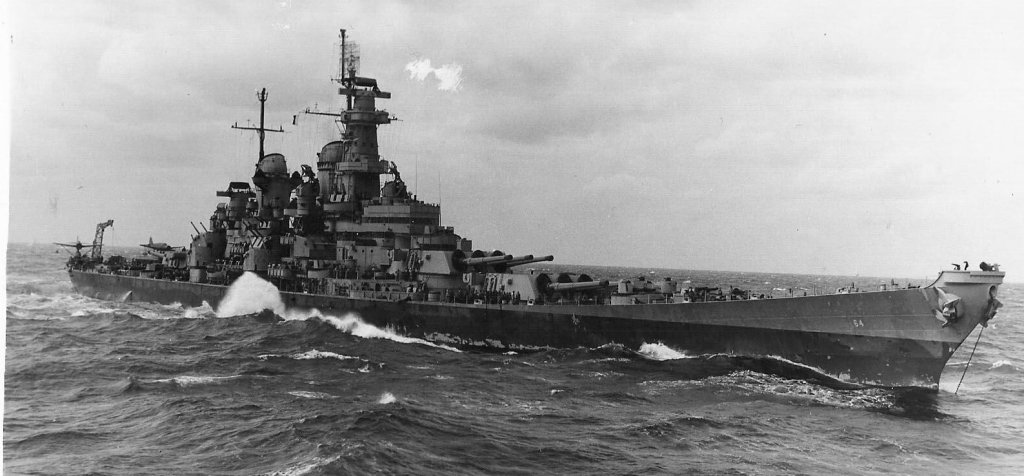"Big Whiskey: A Legacy of Naval Dominance from World War II to the Gulf War"
The Wisconsin joined the Pacific Fleet during World War II, where she played a significant role in providing naval gunfire support during critical operations. Her first major engagement was the Battle of Iwo Jima.
June 18, 2024


The USS Wisconsin (BB-64), an Iowa-class battleship, had a distinguished and multifaceted service history that spanned from World War II through the Gulf War. Laid down on January 25, 1941, at the Philadelphia Navy Yard, she was launched on December 7, 1943, and commissioned on April 16, 1944. The Wisconsin joined the Pacific Fleet during World War II, where she played a significant role in providing naval gunfire support during critical operations. Her first major engagement was the Battle of Iwo Jima, where her formidable 16-inch guns were used to bombard Japanese positions. She later participated in the Okinawa campaign, offering both fire support and anti-aircraft defense against kamikaze attacks, and continued to strike industrial and military targets on the Japanese home islands until the war's end.
Following World War II, Wisconsin was decommissioned in 1948 but returned to service in 1951 due to the Korean War. During this conflict, she provided crucial artillery support during the Inchon and Wonsan landings, bombarding enemy positions and supply routes.
An incident in 1956 where Wisconsin collided with the destroyer USS Eaton necessitated significant repairs, including the replacement of her bow with that of the incomplete USS Kentucky.

Decommissioned again in 1958, Wisconsin entered the reserve fleet, only to be reactivated in 1988 as part of President Reagan's 600-ship Navy initiative. The USS Wisconsin was recommissioned in October 1988 as part of President Ronald Reagan's 600-ship Navy plan. She underwent extensive modernization, including the installation of Tomahawk and Harpoon missile launchers, Phalanx CIWS for close-in defense, and upgraded electronics.

Wisconsin's service during the Gulf War in 1991 marked a new chapter in her storied career. She launched Tomahawk cruise missiles against key Iraqi military targets, demonstrating the utility of battleships in modern warfare. Her 16-inch guns were also used to devastating effect against Iraqi forces during the liberation of Kuwait, reinforcing her status as a formidable naval asset. Decommissioned for the final time in 1991, Wisconsin was struck from the Naval Vessel Register in 2006 and now serves as a museum ship at the Nauticus complex in Norfolk, Virginia. Her legacy as one of the last and most powerful battleships ever built is preserved for future generations, highlighting her significant contributions to American naval history across multiple conflicts.
Design and Specifications
- Class and Type: Iowa-class battleship
- Displacement: 45,000 tons standard; 57,540 tons full load
- Length: 887 feet (270.4 meters)
- Beam: 108 feet 2 inches (32.9 meters)
- Draft: 37 feet 9 inches (11.5 meters)
- Propulsion: 8 Babcock & Wilcox boilers, 4 Westinghouse geared steam turbines, 4 shafts
- Speed: 33 knots (38 mph; 61 km/h)
- Complement: 1,921 officers and enlisted
- Armament:
- 9 × 16-inch (406 mm)/50 caliber Mark 7 guns
- 20 × 5-inch (127 mm)/38 caliber Mark 12 guns
- 80 × 40 mm/56 caliber anti-aircraft guns
- 49 × 20 mm/70 caliber anti-aircraft guns
- Armor: Belt: 12.1 in (307 mm); Deck: 6 in (152 mm); Turrets: 19.7 in (500 mm); Conning tower: 17.3 in (439 mm)
The Iowa-class battleships, including the Wisconsin, were designed to be fast, powerful, and heavily armored. They featured a combination of speed and firepower, with the 16-inch guns capable of firing shells up to 20 miles (32 kilometers) and the speed to keep up with aircraft carriers.
**In June of 2024 Ghosts of the Battlefield received a gift from the USS Wisconsion in the form of one of her 26ft Whaleboats, she will be restored and featured in special events as well as sailing once again.
